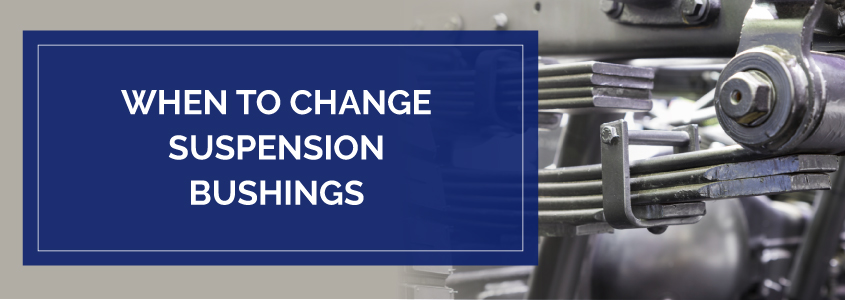What Are Leaf Spring Bushings?
Leaf spring bushings are small, cylindrical-shaped components that are inserted between the leaf spring and the bracket. They serve as a cushion and reduce the friction between the metal components, allowing the leaf spring to pivot correctly.
- Leaf spring bushings are made of durable materials such as polyurethane, rubber, or brass.
- Properly functioning leaf spring bushings improve the performance and safety of the vehicle.
- They absorb shock and vibrations, reducing the impact of uneven roads on the suspension system.
- Leaf spring bushings ensure that the leaf spring and other components stay in their proper position during operation.
They hold the axle firmly in place and reduce friction between parts. However, over time, these bushings can wear out, crack, or become damaged due to constant use and exposure to harsh road conditions. One common red flag indicating worn-out bushings is the sensation of a bumpy ride.
The vehicle may also produce clunking noises while driving on rough terrain. Poor handling and drifting can occur, which can become dangerous if ignored. In this article, we’ll explore the different symptoms of bad leaf spring bushings and how to diagnose them.

Credit: www.generalspringkc.com
Their Importance In The Suspension System Of A Vehicle
The leaf spring bushings’ role in a vehicle’s suspension system cannot be overemphasized. They are necessary for the smooth operation of a vehicle, and without them, the handling and ride quality of the car are affected.
- Leaf spring bushings help distribute the weight of the vehicle evenly across all four wheels.
- They help maintain the vehicle’s steering stability, making it easier to control the car while cornering.
- Properly functioning leaf spring bushings improve the longevity of other components, such as tires and shock absorbers.
- When worn or damaged, leaf spring bushings can cause a variety of issues, including clunking noises, uneven tire wear, and poor alignment.
Leaf spring bushings are often overlooked but play a critical role in the suspension system of a vehicle. Proper maintenance and inspections of these components are essential to ensure that the vehicle stays in top condition, ensuring the safety and comfort of the occupants.
How To Diagnose Bad Leaf Spring Bushings Symptoms
Leaf spring bushings are small rubber or polyurethane components that connect the leaf spring to the frame of a vehicle. They are designed to absorb shocks and vibrations when driving over a rough surface, ensuring a comfortable and smooth ride.
While leaf spring bushings are built to last, they can wear out over time and create various problems for drivers. We will discuss the bad leaf spring bushings symptoms and how to diagnose them.
Bad Leaf Spring Bushings Symptoms
Have you ever felt that your vehicle is shaking or bouncing too much? If yes, then it may be due to worn-out leaf spring bushings. Leaf spring bushings connect the leaf spring eyes to the brackets. They function to absorb the shock and provide a smoother ride.
However, over time, these bushings wear out, leading to multiple problems. We will discuss the symptoms of bad leaf spring bushings and repair and replacement options.
- Excessive vibration: One of the primary symptoms of bad leaf spring bushings is excessive vibration. The worn-out bushings cannot absorb the shocks properly, causing the vehicle to vibrate.
- Clunking noise: When a vehicle with bad leaf spring bushings hits a bump, it produces a clunking noise. It is caused by the loose bushings, which fail to hold the spring properly.
- Poor handling: Worn-out bushings can reduce the vehicle’s handling ability. The vehicle may feel unstable while taking turns, and the steering may start to feel vague.
- Uneven tire wear: If the leaf spring bushings are bad, the tires may wear out unevenly. It is because the wheels are not aligned correctly due to the uneven suspension.
Risks Of Neglecting This Issue
Neglecting the bad leaf spring bushings can lead to severe problems. Some of the risks include:
- Safety hazards: Driving with bad leaf spring bushings can be dangerous. The worn-out bushings can affect braking ability, steering, and handling, leading to accidents.
- Costly damages: Neglecting the bad leaf spring bushings can cause additional wear and damage to other parts of the vehicle, leading to costly repairs.
- Reduction in fuel efficiency: When the leaf spring bushings are bad, the vehicle consumes more fuel. It is because the worn-out bushings put more pressure on the engine, decreasing fuel efficiency.
Options For Repairing Or Replacing Bad Leaf Spring Bushings
If you are experiencing any of the above symptoms, you should get your leaf spring bushings checked as soon as possible. There are two options for repairing or replacing them.
- Repair: If the bushings are not severely damaged, they can be repaired by filling the cracks and holes with a proper bushing adhesive. It is a cheap option, but it may not be a permanent solution.
- Replacement: If the bushings are severely worn out, they need to be replaced. Replacement bushings cost more than repairs, but they are the best option as they provide long-lasting results.
Bad leaf spring bushings can lead to multiple problems, affecting the vehicle’s handling, safety, and fuel efficiency. Therefore, vehicle owners must get their leaf spring bushings checked and replaced if necessary. We hope this article helps you understand the symptoms and repair/replacement options for bad leaf spring bushings.
Frequently Asked Questions Of Bad Leaf Spring Bushings Symptoms
What Are The Signs Of Bad Leaf Spring Bushings?
If you experience clunking and rattling noises while driving, uneven tire wear, or the feeling of the vehicle tipping to one side, it may indicate that the bushings are worn out or damaged.
How Do Bad Leaf Spring Bushings Affect My Vehicle?
If bushings are worn or damaged, they will cause a decrease in handling, reduced stability, and an increase in tire wear. It can cause uneven braking, poor steering, and difficulty in maintaining control of the vehicle.
Can I Drive My Car With Bad Leaf Spring Bushings?
It is not recommended to continue driving a car with worn or damaged leaf spring bushings as it can be dangerous. Worn bushings can cause instability and a loss of control in the car. It’s best to replace the bushings right away.
What Causes Leaf Spring Bushings To Wear Out?
Leaf spring bushings can wear down due to age, weather conditions, excessive use, and lack of lubrication. Old and brittle bushings are more prone to wear and tear due to reduced flexibility and collapse of the rubber material.
How Long Do Leaf Spring Bushings Typically Last?
The lifespan of leaf spring bushings is dependent on the type of vehicle and driving conditions. In general, they can last from 50,000 to 100,000 miles. It is recommended to check them periodically during routine maintenance to ensure they are in good condition.
Conclusion
All in all, bad leaf spring bushings can cause a range of symptoms that affect the overall performance and safety of your vehicle. From uneven tire wear to excessive bouncing and a loss of control while driving, it is essential to identify and address these issues as quickly as possible.
Regular maintenance and inspections can help prevent these problems from occurring, while replacing worn or damaged bushings promptly can help restore your vehicle’s stability and performance. By staying vigilant and taking care of your vehicle, you can ensure that you and your passengers remain safe on the road.
Don’t hesitate to seek professional assistance if you notice any of the symptoms mentioned in this article. Addressing bad leaf spring bushings can make a significant difference in the drivability and lifespan of your vehicle.
